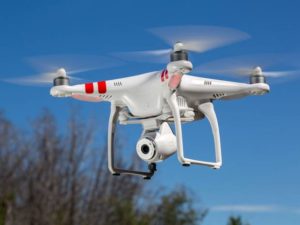Drones and property rights
As recreational drone use expands, hobbyists won’t be the only ones who are flying them. Reports suggest that law enforcement officials are considering adding drones to their tool kit. According to these reports, drones will give law enforcement a bird’s-eye view of major car crashes, active wildfires, and wreckage created by tornadoes and hurricanes.
But might the use of drones in other contexts violate the Fourth Amendment? Law enforcement’s use of drones to examine real property would implicate the Fourth Amendment’s ban on unreasonable searches and seizures. It is important to determine whether the use of drones is a “search” within the meaning of  the Fourth Amendment. If the use of drones results in a “search,” then the government needs to acquire a warrant to examine someone’s property. The use of drones to examine someone’s property will be a search within the meaning of the Fourth Amendment if: (1) the property owner shows a subjective expectation of privacy in the area examined, and (2) if society views that expectation of privacy as reasonable.
the Fourth Amendment. If the use of drones results in a “search,” then the government needs to acquire a warrant to examine someone’s property. The use of drones to examine someone’s property will be a search within the meaning of the Fourth Amendment if: (1) the property owner shows a subjective expectation of privacy in the area examined, and (2) if society views that expectation of privacy as reasonable.
There are some good general rules to remember when thinking about the second prong—whether one has a reasonable expectation of privacy. The Supreme Court has emphasized that constitutional protections are highest inside the home itself. On the other hard, the Court examines four factors to determine whether an examination of the area outside the home, like a yard, porch, or deck, constitutes a search. Those factors are: (1) the distance from the home, (2) whether an area is enclosed by a fence, (3) whether the area is used for intimate activities of the home, and (4) whether the property owner has taken steps to protect the area from observation by people passing by.
Property owners have a legitimate concern that law enforcement may overstep its bounds by using drones because law enforcement officials have previously used cutting-edge technology in a manner that violates people’s constitutional rights. In the 2001 Supreme Court case Kyllo v. United States, law enforcement, without a warrant, used thermal cameras to detect strange heat patterns inside Danny Kyllo’s home. Based on the strange heat patterns, law enforcement obtained a search warrant to search Kyllo’s home; they discovered over 100 marijuana plants growing inside the home.
In that case, the Court held that the use of thermal cameras to examine heat inside someone’s home required a search warrant. Justice Scalia, who authored Kyllo, concluded that “[w]here [. . .] the Government uses a device that is not in general public use, to explore details of the home that would previously have been unknowable without physical intrusion, the surveillance is a ‘search’ and is presumptively unreasonable without a warrant.” In the opinion, Justice Scalia also emphasized the important role that the Fourth Amendment plays in protecting the home. Because the use of the thermal cameras intruded upon a constitutionally protected area—the home—the Court held that there was an unconstitutional search.
Drones may intrude upon a person’s privacy in a manner similar to the thermal cameras used in Kyllo. For instance, drones may be used to examine the contents of someone’s backyard or used to peer through an open second story window of one’s home.
Right now, there is no clear answer as to the question whether the use of a drone to examine someone’s property would require a warrant. Whether the use of a drone is a “search” will be a fact dependent inquiry. For instance, if law enforcement uses a drone to peer through a second story window of one’s home, that is likely a search because officers are examining an area that the Court has afforded very high constitutional protections too. On the other hand, courts will be less likely to hold that flying a drone 500 feet over someone’s uncovered and unfenced backyard is a search. Courts would be less likely to make such a holding because the a property owner who leaves their backyard uncovered and unfenced does not really exhibit any expectation of privacy.
Based on the reports that law enforcement will begin using drones in their operations , it seems likely (if not certain) that there eventually will be constitutional challenges brought to drone use by law enforcement. When judges face questions regarding law enforcement drone use over the home, they must keep one principle in mind: that Fourth Amendment protections are highest in one’s own home. As Justice Scalia explained in Kyllo, “[i]n the home, our cases show, all details are intimate details, because the entire area is held safe from prying government eyes.” Thus, a physical invasion of the home, “by even a fraction of an inch,” requires a warrant. Accordingly, judges should be skeptical of law enforcement’s use of drones when they might infringe on Fourth Amendment protections.

